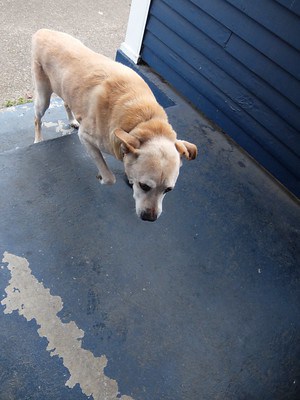
“Hi there! Recently my dog started walking with his head down toward the ground.
When we went for walks before, he would always have his head and tail up and he seemed happy.
He just doesn’t seem himself. Should I be worried?”
Any habits outside of a dog’s normal behavior can be cause for concern. While you should always contact your vet to be sure, here are eight reasons your pooch might be walking with his head towards the ground.
[1] Intervertebral Disc Disease (IDD)
If your dog just started walking with his head down recently, it’s possible that he might have a herniated disc, otherwise known as Intervertebral Disc Disease (IDD).
A dog’s back has “squishy” parts in between their spinal cord to keep the vertebrae safe and well cushioned during movement.
When one of these discs dislodges or moves, it can interfere with the nerves in your dog’s vertebrae. At the very least, this will cause pain and discomfort for the animal—it could certainly cause his gait to change while walking.
If IDD is severe and it goes untreated, it can lead to nerve damage and paralysis.
It’s important to note, there are some dogs that are more predisposed to this condition than others.
For example, dachshunds are notorious for getting IDD due to their elongated backs. IDD is an injury and would likely be caused by an action like jumping onto the couch or playing too hard outside.
[2] Pinched Nerve in the Neck or Spine
Similar to IDD, your dog might be dealing with a pinched nerve.
A pinched nerve tends to happen in the cervical spine, or the neck area of the spinal cord.
The vertebrae in this area of the neck/back tell the dog’s brain to lower or raise his head up. If a disc herniates and affects the nerves in the cervical spine, it can cause what is called a “pinched nerve.”
These injuries are usually caused by trauma or a genetic predisposition.
With a pinched nerve, you might notice a stiff neck, changes in walking patterns, or even proprioception.
[3] Sprained Muscle
A muscle sprain is also a traumatic injury that could cause your dog to walk with his head toward the ground. Sprains deeply upset the ligaments that connect bones.
Just like in humans, dogs have many different bones throughout their body—up to 321 actually! Sprained muscles don’t only happen in the legs, but they can also affect a dog’s back and neck.
While the first warning sign of a sprained muscle is usually limping, it wouldn’t be uncommon for your dog to show other signs of discomfort if the sprained muscle was a section of his spine. If your dog begins walking with his head down and shows signs of discomfort or pain in his legs, he might be dealing with a sprained muscle.
[4] Damage to the Trachea from A Collar Injury
If your dog recently started walking with his head down and this condition began during a routine neighborhood walk, it is certainly important to check for a collapsed trachea or collar injury. There are so many different devices to walk our dogs—training collars, flat collars, martingale collars, harnesses—you name it. If your dog pulls while walking and he is being walked on a collar, it can cause damage to the trachea.
A collapsed trachea is much more common in smaller dog breeds, such as the Yorkshire Terrier or Pomeranian. As the dog pulls during its walk, it puts pressure on the trachea. Because smaller dogs have more fine anatomy, it can cause the entire trachea to collapse. This can trigger difficulty breathing or gasping for air. In addition, it might also cause coughing or hacking, and it can be a reason for dogs to walk with their head down. Tracheal collapse can be diagnosed through Xray and it can be treated through wearing a harness, change in activity level, or even through surgery, if needed.
[5] Degenerative Joint Disease
If your dog is getting older, he could also be dealing with Degenerative Joint Disease (DJD) or osteoarthritis. As dogs age, the cartilage surrounding their joints age, too. This cartilage can deteriorate and cause inflammation to the joints of your dog’s back, neck, and legs. If your dog is walking with his head down, he might be struggling with DJD in his neck or spine. DJD doesn’t happen overnight—you might find your dog has some good days and some more difficult days. He might be less active or develop lameness in his legs.
While we don’t always know what causes Degenerative Joint Disease, there are ways that it can be treated to improve your pet’s quality of life. Physical therapy can help increase joint motion and muscle strength. In more severe cases, surgery can also help to reconstruct or remove joints. If DJD is affecting the cervical spine, medication and anti-inflammatory drugs can also prove to be helpful. Though, always consult an experienced vet before treating your pooch with medication.
[6] Congestive Heart Failure or a Cardiac Disease
If muscle and joint difficulties don’t seem to be part of the equation, Cardiac Disease can also be a reason your dog might be walking with his head down. A dog’s heart beats more than 150,000 times a day. It takes a lot of blood to pump through the heart properly. If your dog is having trouble with circulation through his body or heart, it can cause symptoms such as lethargy, difficulty breathing, coughing, and fainting. If your dog is lethargic, he would struggle to walk normally during your daily walks.
If you suspect your pet might have Cardiac Disease, it’s important to get him diagnosed before he reaches a point of Congestive Heart Failure. Your vet can run bloodwork, Xrays and electrocardiograms (ECG) to help determine the cause of the problem. There are treatments that can help Cardiac Disease, if it is caught early enough, including medications, dietary changes, and modified exercise.
It’s important here to note that Cardiac Disease can be more common in some dog breeds than others. Breeds that are predisposed to heart failure are Poodles, Great Danes, and Boston Terriers.
[7] Heat Stroke or Heat Intolerance
Heat Intolerance or Heat Stroke might also cause a dog to walk with their head down. If your dog starts walking with their head down and they walked with their head raised yesterday, they might be struggling with heat stroke. Some dogs struggle to regulate their body temperature when it’s warm outside. If the ground outside is warm, and you have a small dog, their body can actually absorb the heat from the pavement or concrete quickly.
Some of the most common symptoms of Heat Stroke are excessive panting, vomiting, pale gums, and thick saliva/drooling. Heat stroke can cause a dog to become lethargic quickly and it could result in behavior like walking with their head down.
If you suspect that your dog might have heat stroke, be sure to get him to a vet immediately. Heat stroke is a life-threatening condition that can be treated, if caught in time. Undiagnosed complications can cause internal bleeding and damage, so it’s important to treat him right away if heat stroke might be the cause of him walking with his head down.
[8] Cognitive Dysfunction Syndrome
If your dog is walking with his head down and it doesn’t seem to be muscle related, or affecting any other specific parts of his body, it might also be helpful to consider Cognitive Dysfunction Syndrome (CDS). CDS typically happens in dogs older than 12 years of age. Affected dogs develop a “sticky” build up of plaque in the frontal lobe of their brain as they get older. This plaque causes disorientation, lack of spatial awareness, and extreme changes in vision and/or hearing.
Cognitive Dysfunction Syndrome probably won’t happen overnight. Your dog might start showing signs of disorientation around the house or forgetting where he’s at. He might defecate inside, or struggle to hold his bladder. Many dogs with CDS also struggle with disturbances in their sleep cycle, which can cause changes in activity and anxiety. As these changes begin, your dog might show other signs of discomfort, such as pacing, irritability, or walking with his head down.
While much of the treatment for CDS is managing the symptoms as dogs age with the condition, there are helpful therapies that can improve your dog’s quality of life. If your dog is walking with his head down inside, throughout the day, it might be a good idea to consult a veterinarian to obtain an accurate diagnosis.
Closing Thoughts
Any changes in your dog’s daily routine can be cause for concern. Dogs are creatures of habit and enjoy their routines. If your dog is walking with his head down, it’s important to consider some of the various health conditions that might cause this behavior. Observing your dog’s daily patterns in activity can help determine whether his condition might be muscle related, spinal related, cardiac related, or even heart related.
In the event of a health change, please remember to consult your dog’s veterinary team if his behavior continues and medical treatment is necessary.






